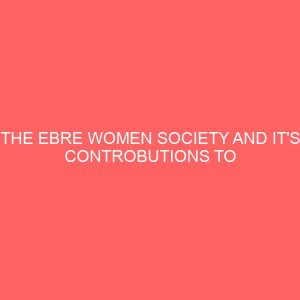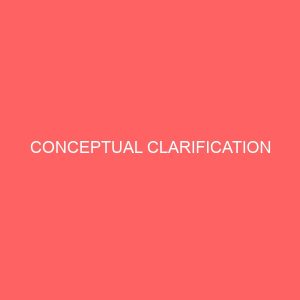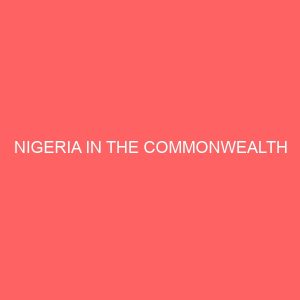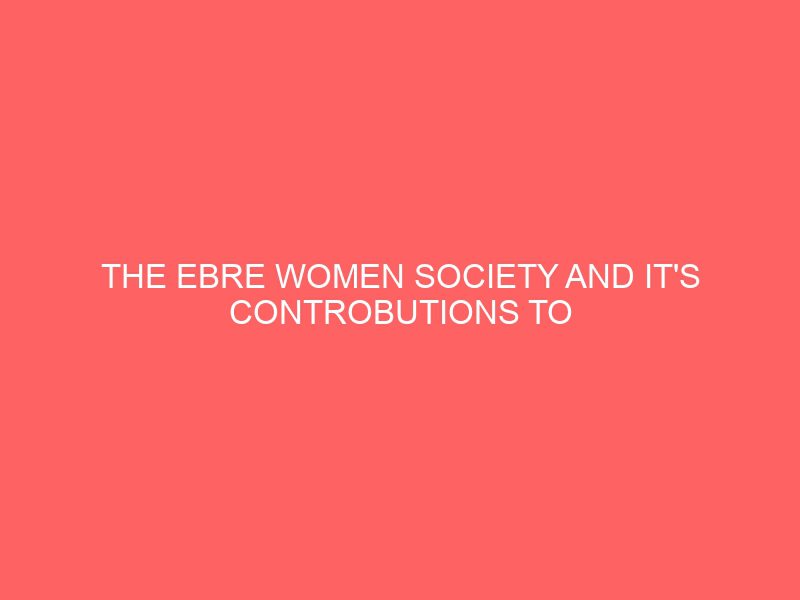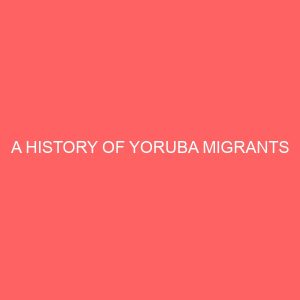Description
CHAPTER ONE
INTRODUCTION
Mkpat Enin society in the pre-colonial era was a well ordered society in which women played significant roles in their age grade and exclusive societies which served as important arms of government in the land.1 The women exclusive societies were vocal, active and were organized to deal effectively with matters concerning women, maintaining good moral among women and protecting themselves against maltreatment by husbands or men generally. One of such societies was EBRE WOMEN SOCIETY.
Ebre women society was a ritual dance in honour of the ancestral mothers and was very popular in pre-colonial era because of its social, political, judicial and educational functions. Their contributions or influence was not limited to the village but extended to the village groups.2 They played important roles in moral education, political sensitization, sanction mutual aid and the preservation of the rights of the female sex.3 Moreso, it provided a forum for women to devise means of disciplining girls and training them on economic, moral and social ethics. They used this opportunity to formulate and discuss policies for the handling of girls during circumcision, fattening and during other significant events in their times.
Ebre music or songs articulated the hopes and aspirations of the women and their references were drawn from the day to day experiences. When the ebre women danced, it was not only for entertainment but also as an instrument of social control while some were a deliberate protest against what they regarded as male chauvinism.4 Moreso, the vulgarity of some of their song texts and ballads reflected their desire to inculcate moral discipline, obedience, respect in the youth and entire people. Ebre dance was accompanied by full orchestra of wooden drum, rattle and gong which were simple and locally made and were played by the members according to how each of them specializes on them.5
The Ebre women raised their fund through the initiation fees paid by new members, heavy fines imposed on men who abused their wives and though the donations of well wishers whenever the Ebre dance was staged and through the money charge by them whenever they were hired to play and dance on special occasion. A typical Ebre women was identified with 2 pieces of wrapper which the eye of the owner considered superior, blouse, headtie and a string of beads tied around their neck. Among the important paraphernalia of this group are the Ekuriku staff which was also used by members of Idiong and Ekong societies and symbolized authority as well as “akpan Udua” (traditional woven basket) which depicts their occupation of farming and trading.6
EBRE SOCIETY existed as a traditional forum for the political participation of women. Whereafter, this society was suppressed or restricted in scope by the colonial administration. This society, as a political structure enabled women’s voices to be heard, their opinion consulted and their participation guaranteed from the family households to the councils in the larger society.7
At the dawn of the contemporary period, Ebre society metamorphose into a political forum for women and are organized around definite political, social, economic, professional and class interest. They aspire for political development and representation as well as national development and they thrive alongside with male folk.8 They participate actively in politics by mobilizing and organizing women as interest groups, pressure groups and NGOs which helps in furthering the course of women9.
1.1 STATEMENT OF PROBLEM
The most outstanding problem that necessitate this research span from the total negligence of studies on Ebre women in the Nigerian historiography. It is observed that much has been written on the important role played by men in their various societies in pre-colonial era whereas “Ebre society” whose members form the bedrock of today’s women in politics have been neglected.
On the otherhand, majority of the people regard women as necessary appendages with clearly defined and circumscribed roles which were calculated at advancing the pervasive interest of the male without recognizing the potential powers of women.
On the whole, the researcher in carrying out this research, tries to demystify the conception that Ebre society was more of a fraternity than a social club.
OBJECTIVES OF THE STUDY
The research is conducted to achieve the following:
It is an attempt to examine the roles, contributions and status of Ebre women in the social development of Mkpat Enin L.G.A.
It is the intension of this research to evaluate the extent of women’s involvement in the governance of the society in the pre-colonial period.
This work also intends to bring to limelight the place of Ebre women in contemporary society-politically.
SIGNIFICANCE OF THE STUDY
This work is an attempt to stem the tide of negligence as far as the study of Ebre women society in Mkpat Enin L.G.A. is concerned.
This work will serve as a useful contribution to highlight that the women of Mkpat Enin L.G.A. has contributed substantially to the development of the area irrespective of their political affiliations.
This work being an academic inquiry on Ebre women will justify the vibrant role played by women in the political scene today.
This work will go a long way to boost the existing literature on women and thus fill the gap which exist on account of the death of written records about women.
The work will serve as an eye opener to the government on the need to recognize women and their groups, and thus help government to give women the recommended 30% of elective and appointive positions in government.
SCOPE OF STUDY
This research work covers a wide range of areas. It incorporates all the necessary facts about Ebre Women Society.
It discusses is full detail the activities and contributions of the society aimed at the socio-political development of Mkpat Enin society in pre-colonial time.
The study extends to examine the roles and place of Ebre women in contemporary society – politically.
LITERATURE REVIEW
Among the books reviewed include Daryll Forde and G.I. Jones (1950), The Ibo and Ibibio – Speaking Peoples of South – Eastern Nigeria, agrees that membership in Ebre was open to women of all ages; it has authority over unmarried girls; supervising the fattening house and other ceremonies concerning them. It also celebrate annually the harvesting of women’s yam known as Abre.
Udo Udoma (1981),The Story of the Ibibio Union, maintains that Ebre society was exclusively for women of high distinction and moral probity. In his view, Ebre society was one of the institutions responsible for the wielding of power; having a well defined area of authority and it was a highly disciplined organization.
Commenting further on Ebre women’s society, Edet A. Udo (1983), Who are the Ibibio?, tries to explain that the entrance fee was quite high but each woman received financial help from her husband, her relatives and well wishers just to become a member of this prestigious society.
The work of Ekong Ekong (2001), The Sociology of the Ibibio, ascertains that women of easy virtue and thieves were exposed and expelled from this traditional society and in this way the society served mainly as a control on the morals of women in the society. In the same vein, Peter, Iwok and Uya (1994), Akwa Ibom State, the Land of Promise: A Compendium, gives a detail account that the female institution appears to be so named because it was especially established to check the stealing of this particular foodcrop. They maintain that members of the Ebre club were usually married women of proven reputation and integrity. Their function in the pre-colonial times was to regulate the conduct of its members to ensure good discipline and behaviour among them and all women generally. Most importantly they served the interest of men.
Antia (2005), Akwa Ibom Cultural Heritage, presents Ebre women society as an exclusive women’s play consisting of morally upright, industrious and honest women. However, he did not explained their functions but emphasized on membership qualifications.
A. Talbot (1968), Women’s Mysteries of a Primitive people: The Ibibios of Southern Nigeria, describe Ebre as a play which started among the ubium Ibibios. She went further to describe the dress code of Ebre members which in her opinion was rather costly so that only the wealthy were able to join it. In her view, this association strike a note midway between freemansory and trade unionism and form the only safeguard of Ibibio women against the tyranny of their men-folk.
Badejo (1985), Women in Nigeria Today, is a very important work on women in contemporary times. Badejo gives helpful insight into the modern place of Ebre women in the political scene. These women represent the voice of the oppressed masses of women and they participate actively in politics so as to further the course of women.
Lemuel Owugah (2003), “Gender and Political Empowerment: The Nigerian experience” in The Art and Science of Politics, is an important article on women political awareness. She emphasized that it was the United Nations Decade for women that gingered the 1995 Beijing World Conference on women to shift in focus from Liberation to political empowerment in the struggle for Gender equality.
From the foregoing, it is evident that there exists rich literature on Ebre society in the pre-colonial era but less effort has been made in trying to examine its place in the contemporary society. Thus, this project tries to argue that Ebre women and their social activities in the pre-colonial era forms a stepping stone to women appearance in the public political scene. Ebre women are therefore seen as active catalyst in the socio-political development of not only Mkpat Enin but also Ibibioland. This could be seen as the 1929 women’s war in Opobo (Ikot Abasi) had Ibibo women as participants, who paid the capital price with their own lives for the historical and political development of Nigeria.
METHODOLOGY / LIMITATION
Women history falls within the same category as social history and therefore is basically multi-disciplinary in approach. The researcher as an indigene of Mkpat Enin is aware of the fact that only marginal mention has always been made by most writers about Ebre society in text books. Most of these writers hardly adhere to the call by E.A. Afigbo to review women’s study with a view to portraying the women’s action especially the 1929 event in the right perspective. On the otherhand, most of the write-ups on women take to western theories, and thus, make such monographs on Ibibio women to lack the insiders approach. With these difficulties, the researcher employed circumspection in sighting the relevant materials from the irrelevant ones.
From the above, it could be seen that materials for this project were collected from oral and written sources. Oral tradition can be defined as “all verbal testimonies which were reported statements concerning the past”.10 Oral tradition also has to do with oral literature including myth, poetry, epic, folklore, legend, eye-witnesses accounts or oral history.11 Great wisdom is however contained in oral tradition and if carefully analysed, can provide materials for the reconstruction of history of extinct communities. By and large, knowledgeable people who exhibited good knowledge of the functioning of Ebre society in the Mkpat Enin area were interviewed and written materials were also collected from private, public and the university libraries.
This project was not completed without certain constraints. For instance, there was no archaeological excavation in Mkapt Enin L.G.A. and this posed some problems in the area of writing out the origin and migration of the Mkpat Enin people. The research into Ebre society in Mkpat Enin is confronted with several problems. The most important and most obvious is the death of relevant materials about Ebre society.
For this project, it must be emphasized that written sources can not be exclusively relied upon as complete and comprehensive resources. One reason is that most of the earlier records derived from Europeans and Arabic sources must be considered external source materials subject to distortion and misrepresentation characteristic of such data. Thus, oral tradition must be considered a vital source for the purpose of corroboration and clarity. According to E.J. Alagoa, “Oral traditions is historical information transmitted orally by processes peculiar to each community and which should be studied first in the context of its culture before being made available for cross-cultural analysis and comparison”.12 This is moreso when we remember that writing does not succeed in capturing all the vital information even in societies in which writing is fully established.
The issue of selection and processing of data posed another problem for the researcher which was confirmed in the eloquent expression of E. J. Alagoa that “the ethnographic present in which most traditional anthropologists wrote makes their works problematic for historians seeking to reconstruct the pre-colonial past. Deciding on how to use these works in a historically sensitive manner is among the most demanding methodological tasks of African social historians.13
On the otherhand, the field study of this project was undertaken within a comparative short period. Apart from the tight schedule of most informants which made it difficult for them to keep appointments and resulted in repeated visits to certain areas by the researcher, she was also exposed to some financial problems as a self sponsoring student. Moreso, the attitude of some informants in respect to questions asked had posed a great deal of impediments to the researcher’s efforts. For instance, some informants refused to talk about certain areas like ritualism and burial rites which they felt they were not well informed. Others who agreed to talk related their information in a fragmented manner. This confirmed what E. J. Alagoa said that “oral tradition are faced with the problem of datation and chronology, reliability and techniques of analysis all bothering on the temperament of the writer”14.
Despite these constraints, the inter-disciplinary approach to historical writing was adopted. This resulted from the fact that the different sources of historical reconstruction are all related. Therefore, the weakness of a particular area was complemented by the strength of the other and vice versa. The study was also made possible because of the researcher’s courage, sense of purpose, gentle persistence from door to door enquiry and my painstaking explanation of the research as being solely educational.
On the whole, there is no claim to perfection of any nature as far as this study is concerned. It should rather be seen as an attempt to interpret historical phenomenon within the limits of available resources. Blame of whatever nature should go the researcher and scholarly reactions provoked as a result of this study are welcomed. This is in accordance with the view of Arnold Toynebee that “for a person to make meaningful contributions to the advancement of knowledge, his studies must have provoked some criticisms and further researches.15
From the foregoing, the above chapter gives an insight into the “Ebre women society” in pre colonial Mkpat Enin while the next chapter will trace the origin of Mkpat Enin L.G.A. as well as the origin and status of Ebre women society.

